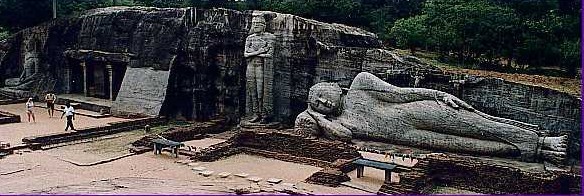
Gal
Vihara

To the north of the Kirivehera and worthy
of a trip just to see this one site alone is the Galvihara, a
complex carved entirely from the existing stone. As the photo above
attests, the site is remarkably compact, and filled with incredible
sculptures. The tour of the Galvihara begins at the extreme left of the
picture above with the figure of the Buddha standing on a lotus plinth
in the "blessing posture," with his arms folded and eyes half-closed.
(photo to the left) The coloring of the granite shows through clearly
in the dark horizontal streaks through the icon's mid-section. Close
inspection of the larger image will show the image is surrounded by reliefs of temples, affording
some indication of what the temples of Polunnaruwa originally looked
like. Next to the Buddha is a rock-cut temple containing another seated
Buddha surrounded by attendants and other decorations which still bear
small flecks of their original paint.
(photo at the above right) Adjacent to the
rock-cut temple is a large inscription recording in detail King
Parakrambahu's efforts to unite the Buddhist order by establishing
uniform rules of conduct. It is shown in the photo at the top,
sandwiched between the rock-cut

Video Tour
of Gal Vihara